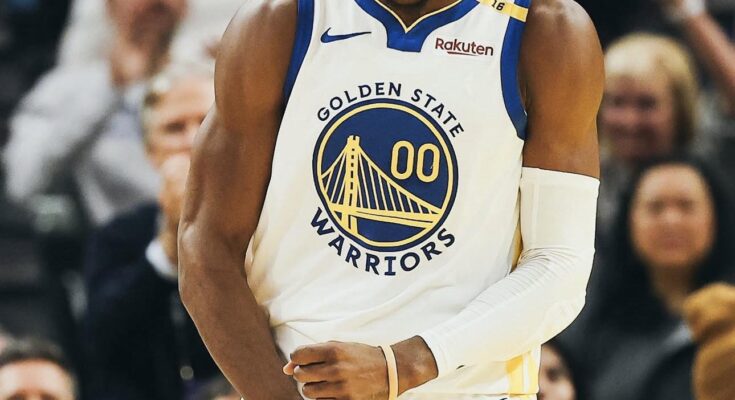Jonathan Kuminga wants a 4-year, \$90 million contract with a player option from the Golden State Warriors. This latest development adds yet another layer of intrigue to Golden State’s offseason as the franchise continues to juggle the balance between keeping its championship core intact while also preparing for the future. For Kuminga, this contract demand isn’t just about securing financial stability; it represents his desire to be recognized as a central piece of the Warriors’ next era. For the Warriors, it forces them into a crossroads between paying up for a still-developing young star or recalibrating their roster in a way that allows them to remain competitive in a brutally tough Western Conference.
Kuminga has been one of the most polarizing players on Golden State’s roster since being drafted seventh overall in 2021. His raw athleticism, defensive versatility, and flashes of offensive brilliance have often been offset by stretches of inconsistency and questions about his fit within the Warriors’ system. Still, at just 22 years old, his upside remains enormous. He’s shown the ability to score in bunches, defend multiple positions, and thrive in transition, all of which make him one of the most intriguing young wings in the league. His growth over the past season has only added to the argument that he’s ready to take on a much larger role, and with Klay Thompson’s future uncertain and Draymond Green aging, the timing of his contract demands may not be coincidental.
Golden State is in a complicated situation financially. The team has one of the league’s highest payrolls, thanks largely to massive contracts for Stephen Curry, Draymond Green, and Andrew Wiggins. With the new NBA collective bargaining agreement placing even harsher penalties on teams that exceed the second luxury tax apron, every dollar the Warriors commit moving forward carries heavy consequences. This is what makes Kuminga’s \$90 million ask a significant talking point. On paper, four years for \$90 million averages out to \$22.5 million per season—a number that is in line with what other promising young wings around the league have received. However, with Golden State’s tax implications, that figure multiplies dramatically, potentially making him much more expensive in practice.
From Kuminga’s perspective, the demand makes sense. He has steadily improved each year in the NBA, becoming a more reliable offensive weapon while also showing signs of blossoming into a two-way force. His athleticism is unmatched on the Warriors’ roster, and when given the opportunity, he’s proven that he can swing games with his energy and scoring ability. There’s also a sense of urgency from his camp—he knows that as the Warriors lean into their younger talent, this may be his best chance to cash in before the team makes any drastic roster changes. A player option in the final year gives him security while still allowing flexibility to test the market again while in his prime.
The Warriors, however, have reasons to be cautious. While Kuminga has had stretches of brilliance, he’s also had long stretches where his production has dipped, and questions about his consistency remain. He has yet to fully establish himself as a reliable starter throughout a full season, and there are lingering concerns about his fit alongside Curry, Green, and Wiggins. Additionally, the Warriors have to consider what committing to Kuminga at this number means for the rest of their roster. Paying him could limit their flexibility to add veteran talent, and with Curry still playing at an MVP level, the franchise doesn’t want to squander the final years of its franchise cornerstone by being financially handcuffed.
Still, the Warriors also know the dangers of letting a young talent like Kuminga slip away. Around the league, other teams are monitoring this situation closely, knowing that a 22-year-old forward with his physical tools and improving skill set doesn’t become available often. If the Warriors balk at his demands, trade speculation could heat up quickly. There have already been whispers that teams would be willing to offer significant assets for Kuminga, especially franchises looking for a long-term cornerstone. Golden State must weigh whether paying him now is more beneficial than potentially losing him or being forced into a trade they might regret later.
The timing of this news is also critical. The Warriors have decisions to make on several fronts, including the futures of Klay Thompson and Chris Paul. Thompson, a franchise icon, is heading into free agency, and while his best years may be behind him, his leadership and shooting are still valuable. Chris Paul’s situation is also unresolved, and his contract could be used as a trade piece to bring in fresh talent. With so much uncertainty, Kuminga’s contract demand could push the front office to clarify its long-term vision sooner rather than later.
This also raises the broader question of what the Warriors want to be. Do they want to maximize the present by continuing to load the roster with veterans who can help Curry contend for another championship immediately? Or do they want to bridge into a new era by empowering young players like Kuminga, Moses Moody, and Brandin Podziemski to become the foundation for the future? Paying Kuminga \$90 million would be a clear indication that they see him as a centerpiece of the next phase. Hesitation, on the other hand, would suggest they may be more inclined to explore trade avenues or seek short-term solutions around Curry.
From a market perspective, Kuminga’s ask is not unreasonable. Players like Jaden McDaniels in Minnesota and De’Andre Hunter in Atlanta have signed deals in a similar range. The difference, of course, is that those teams are not operating under the financial constraints that Golden State is. For the Warriors, every decision is magnified because of the tax implications, meaning what looks like a fair deal in a vacuum could be crippling under their circumstances. The question becomes whether they believe Kuminga can evolve into a star-level player who justifies not just the \$90 million, but the much larger financial hit the team would take.
Stephen Curry’s voice in this process cannot be underestimated. As the face of the franchise and one of the greatest players in NBA history, his input on roster decisions has always carried weight. If Curry sees Kuminga as someone who can grow into a legitimate co-star over the next few years, that could tip the scales in Kuminga’s favor. On the other hand, if Curry feels the team’s window is too short to wait for Kuminga to fully develop, the Warriors might prioritize veterans who can contribute immediately.
Fans are also divided on the issue. Many have been clamoring for Kuminga to receive a bigger role, especially during stretches when the team struggled with athleticism and scoring depth. They see him as a future All-Star whose best years are ahead of him. Others worry that his inconsistency makes him too risky to commit such a significant chunk of money to, especially when the team’s payroll is already bloated.
Ultimately, Kuminga’s demand for a 4-year, \$90 million contract with a player option is less about the numbers themselves and more about the Warriors’ identity and direction. Do they see him as a foundational piece worthy of long-term investment, or do they view him as a valuable trade asset who can be flipped for more immediate help? The decision won’t just impact Kuminga—it will define the trajectory of the franchise for years to come.
If Golden State agrees to the deal, it locks in Kuminga as part of the franchise’s future, signaling a belief in his development and a willingness to endure the financial penalties that come with it. If they push back, the Warriors could be heading toward a messy standoff that ends with Kuminga on a new team. Either way, the coming weeks promise to be pivotal, as both sides negotiate not just dollars, but the future of one of the NBA’s most iconic dynasties.
The clock is ticking, and while \$90 million over four years might seem like a straightforward negotiation for a player of Kuminga’s potential, in Golden State’s unique financial and competitive landscape, it represents a high-stakes gamble. Whether the Warriors are willing to take that gamble could determine whether their dynasty has one more chapter—or whether it’s time to turn the page.



